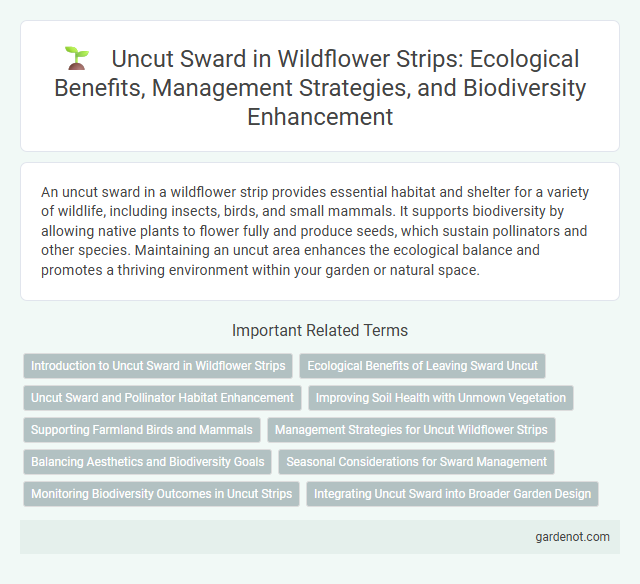An uncut sward in a wildflower strip provides essential habitat and shelter for a variety of wildlife, including insects, birds, and small mammals. It supports biodiversity by allowing native plants to flower fully and produce seeds, which sustain pollinators and other species. Maintaining an uncut area enhances the ecological balance and promotes a thriving environment within your garden or natural space.
Introduction to Uncut Sward in Wildflower Strips
Uncut sward in wildflower strips refers to areas of naturally growing grasses and plants left undisturbed to enhance biodiversity. This practice supports pollinators and beneficial insects by providing continuous habitat and food sources throughout the growing season. Maintaining uncut swards promotes ecological balance and increases the overall health of wildflower ecosystems.
Ecological Benefits of Leaving Sward Uncut
Leaving the wildflower strip sward uncut promotes biodiversity by providing essential habitats and food sources for pollinators such as bees and butterflies. The uncut vegetation supports soil health through enhanced organic matter and moisture retention, contributing to ecosystem resilience. This practice also helps in carbon sequestration, mitigating climate change impacts by storing more carbon in plant biomass and soil.
Uncut Sward and Pollinator Habitat Enhancement
Uncut sward areas maintain diverse native grasses and wildflowers essential for pollinator habitat enhancement by providing continuous nectar sources and nesting sites. Preserving these unsprayed, unmown strips supports increased biodiversity, attracting bees, butterflies, and other beneficial insects crucial for ecosystem health. Effective management of uncut swards promotes ecological balance and boosts pollinator populations, vital for wildflower reproduction and agricultural productivity.
Improving Soil Health with Unmown Vegetation
Uncut sward in wildflower strips enhances soil health by promoting microbial diversity and improving nutrient cycling through natural decomposition. The unmown vegetation increases organic matter and soil structure, leading to better water retention and erosion control. Maintaining these strips without mowing supports a balanced ecosystem, fostering healthier plant growth and resilient soil.
Supporting Farmland Birds and Mammals
An uncut sward in a wildflower strip provides essential habitat and foraging opportunities for farmland birds such as skylarks and meadow pipits, as well as mammals like hedgehogs and field voles. Retaining taller vegetation and seed heads supports nesting sites and food availability throughout the breeding season and into autumn. This management practice enhances biodiversity by promoting insect populations that sustain higher trophic levels on agricultural landscapes.
Management Strategies for Uncut Wildflower Strips
Uncut wildflower strips require careful management strategies to maintain biodiversity and habitat quality, including selective mowing after seed set to promote natural regeneration. Monitoring sward height and diversity helps optimize conditions for pollinators and ground-nesting insects, balancing vegetation density without compromising floral variety. Incorporating seasonal cutting regimes and avoiding fertilizer or pesticide use enhances ecosystem resilience and supports native wildflower species.
Balancing Aesthetics and Biodiversity Goals
An uncut sward in a wildflower strip creates a vital habitat that supports pollinators and diverse wildlife, enhancing biodiversity while contributing to a natural, rustic aesthetic. Maintaining varied vegetation height encourages flowering plants to complete their life cycles, promoting seed dispersal and soil health. Selecting native species and timing periodic cuts carefully helps balance visual appeal with ecological functions.
Seasonal Considerations for Sward Management
Uncut swards in wildflower strips provide vital habitats for pollinators and wildlife, enhancing biodiversity through each season. Seasonal considerations for sward management include timing cuts after peak flowering to preserve seed heads while supporting insect life cycles in spring and summer. Leaving uncut patches during autumn and winter ensures shelter and food availability for overwintering species and soil health.
Monitoring Biodiversity Outcomes in Uncut Strips
Monitoring biodiversity outcomes in uncut wildflower strips reveals increased species richness and abundance of pollinators such as bees and butterflies. These uncut swards provide essential habitat connectivity and food resources, supporting ecosystem functions like pollination and pest control. Long-term biodiversity assessments emphasize the importance of maintaining uncut areas to enhance habitat diversity and ecological resilience.
Integrating Uncut Sward into Broader Garden Design
Integrating uncut sward into broader garden design enhances biodiversity by providing vital habitats for pollinators and wildlife within wildflower strips. Maintaining varied mowing regimes preserves structural diversity, promoting ecological balance and seasonal interest throughout the garden. Thoughtful placement of uncut swards alongside pathways and cultivated areas creates a naturalistic aesthetic while supporting ecosystem services.
Uncut sward Infographic

 gardenot.com
gardenot.com